Trackmag is a blog dedicated to the analysis and reviews of musicvideos. Written/Curated by TaylorJoeBerger keep scrolling for previous entries.
Don't wanna be here? Send us removal request.
Text
THE KING AND HER DEMONS
Ever since Florence + The Machine came out with their very first full-length album Lungs, they have been creating dreamy, otherworldly visuals alongside their unique and equally grand sound. Be it the charming, very DIY video for Dog Days Are Over or an entire film project split into chapters as seen in her The Odyssey series, which holds one of my personal favourites of theirs (speaking musically and visually) St. Jude. Clearly Florence Welch is as much a visual artist as she is a songwriter and vocalist. She did after all briefly go to Camberwell College of Arts before fully focusing on her music career. In this Blogpost, I am going to explore what possible inspirations and references were gathered to create this most recent video by Florence and director Autumn De Wilde: KING.
Of Kings, Snails, And Mothers
The video starts with the word KING across the screen in a dark royal purple. An agitated man is sitting in an abandoned-looking office building. The shelves are empty and placed randomly as if most of the interior had been moved out already. The floor, columns, and ceiling are stone/ cement maybe even marble. The walls are made up of very large windows letting in a lot of light from the left side of the frame. The light and the shapes on the ceiling convey a kind of sacred or chapel-like ambiance.
The man, clothed completely in black is upset. The camera moves towards him, revealing a figure in the background in a royal purple cape, previously hidden by a column. This reveal is underlined by a haunting sound; a gasp for air. A close-up confirms: this is Florence.

(Florence reminiscent of Mater Dolorosa in KING)
Standing still, hands folded, surrounded by bright light, she is placed on top of what appears to be a brick of marble, making her a statue of sorts. Her placement, garment and pose reminiscing paintings and sculptures of The Holy Mother Mary. “Mater Dolorosa” explicitly depicts the always worrying restless mother. Pietà, the mother grieving over her son. The bright light completes this serene image and makes it even more sacrosanct. The colour purple indicates high rank, be it in a religious or royal context as this pigment, made from the shells of marine snails (Hexaplex trunculus, Bolinus brandaris, and Stramonita haemostoma), was considered to be the rarest and most expensive.

(Maria als Schmerzensmutter, Albrecht Dürer, 1495/98)
Florence seems calm, indifferent. The words leaving her lips are extremely potent, she remains statuesque. After singing “I am no mother, I am no bride, I am KING” she seems to be slowly released from her so far fixed position, as we see more and more movement in her body. There is a tension between what was earlier described as Holy Mary imagery and the very harshly contrasting lyrics:
“I am no mother…” The man feels a presence behind him, horror covers his face, he turns around to see Florence now floating outside, opening the window, therefore entering his space and with one gesture commanding him across the room into her arms.
“I am no bride…”
She holds him in an affectionate but also threatening embrace and together they fly upwards in a straight line.
“I am… KING”
On the word King, we hear the cymbal and a brutal crack, enhanced by the “K” in King as Florence snaps his neck. Now wearing a smirk, as she took his life with one swift move.
Florence seems invigorated by this as we see her breath in the now dark cool night air while her victim remains still. A third character is revealed standing below the scene, facing away. A young man also clothed in black, his breath reveals he is alive. His demeanour is focused but he also seems nervous.

Catch A Breath
Familiars are believed to be spirits assisting witches in their magic. Often, they are depicted as animals, such as a black cat or a toad, but they can also have a human form. A common name for them would also be demons or fairies, depending on whether they are considered malevolent or benevolent. More recent definitions of familiars would be mortals assisting immortal beings in hopes of receiving some sort of magical education or even the secrets to immortality. An example for this would be the relationship between a vampire and his familiar. The familiar works for their master for the promise of being turned, thus also becoming immortal. Perhaps this new character following Florence throughout the video but remaining very passive and docile could be a sort of familiar to her, which would make her a witch, vampire, or immortal being of sort.
“What strange claws are these”
She sings with a confused look on her face, is she coming into her own power? We see her leading the way, still floating above the ground, the dead man floating behind her, and the familiar walking at the end.
“I am no mother, I am no bride, I am King”
This time around in a more sinister, seducing, dark voice, quietly confident.

We cut away to what looks like undead bridesmaids crawling up a large flight of stairs. Now in a huge, brutalist building, hollowed out, empty, only a skeleton of what it was, nevertheless appearing sacred. The shot is reminiscent of any zombie movie. This seems fitting since folklore around zombies and vampires started with the term undead and described a being awakening in their grave eating away at their own flesh. It was believed that as long as they had something to eat misfortune would come to the relatives of the deceased and the people living close to the cemetery. This belief encouraged people to preventive staking of the corpses before burying and other gruesome practices. Vampires and zombies alike derive from such stories, more and more elaborate details were added to the creature over time, that would end up being the death-bringing, youthful, seductive vampire, often hyper-sexualized as the stories around them reached their height in popularity and fascination during a very strict, religious and therefore prude time. The tales surrounding vampires enabled people to express their phantasies and demons without claiming them to be their own, as it was said that if vampires found an interest in you they would often find you in your dreams, speak to you, seduce you before paying you a deadly visit. Not uncommon were stories of female vampires who would prefer women, claiming them as lovers before giving them their final kiss.

(Vampire, Edvard Munch, 1895)
The women in their lavender dresses are also wearing a sort of ring around their necks, perhaps suggesting previous imprisonment or a collar left from a domestic cage? They gather around Florence, who leads them into doing a simple choreography: “I am no mother” swaying from left to right holding their stomachs, “I am no bride” folding their hands in prayer, still ducked and with small posture, “I am King” now closing their right fists and standing tall.
Break The Circle
Florence’s vocals fall back, become softer, quieter and the music fades… A small rumble of a drum remains, the young women gathered around in a circle, fists still in the air, faces torn by their wide-open mouths as they scream in silence. A drum roll hits and Florence’s voice soars through the track! Still reminiscent of Pietà while her disciples go crazy around her, pulling their skirts, stomping around, revealing snarling faces whilst prancing about. Florence suddenly breaks loose from within the circle with a firm step heightened by the enormous sound of the song. The heaviness seems to disperse and in its place, there’s exhilaration and joy.

The young women now in formation are circled by Florence in what only can be described as a kind of initiation ritual. Perhaps these young women are next in line to receive their powers, similar to what is described in pagan traditions as the Witches’ Sabbath. These were secret meetings and celebrations held between witches, sorcerers, and the devil where they would scheme and plot for the coming year. The ritual was believed to be held on the turn of spring, announcing the change of the season.
The music and the scenery calm down. The great cement wall as a backdrop now is smeared with pink. Floating in the very centre, moving her cape like the wings of a bat, we have the sorceress conducting a band that appears to be made up of previous victims. All men dressed in black. All petrified in mid-air, together forming an arch. Her latest victim hovering next to the familiar. The other women are now dancing in a more controlled and slowed-down fashion, turning on the spot.
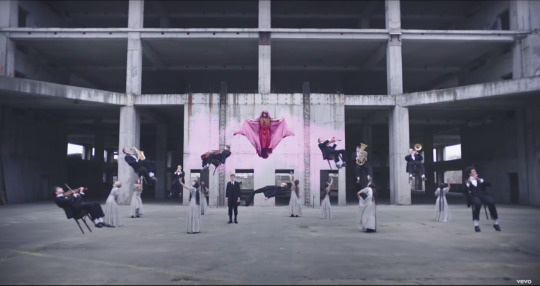
Suddenly back where it all started, we see the scared expression of the previously dead man. But this time around Florence is standing on one of the remaining desks in the office. In a very blurry frame, we see the silhouette of the man on the right. And for a second, also blurry, the lights flicker and fail soon after as the image becomes clearer. Was this a sign? A warning? The lights signalling the end of the illusion? As in Film daydreams and such mostly are disrupted by an intrusion of sorts, a loud car or a ringing telephone for example, perhaps this flicker of the lights, functions in a similar way?
The man hurries to Florence, seeking refuge, comfort in her arms. She caresses his face, bends over him to presumably kiss him, but the fabric of her cape and hood swallows him as we once again hear the unnerving sound of her sucking in the air. The man is consumed by her.
Was this all a dream? A hallucination? This is where we delve into the myth of the Boo-Hag. Often compared to vampires, the Boo-Hag is a creature that shares many similarities with them yet does not feast on their victims’ blood but breath. Often, they would sit on their victim while they were asleep and bring them chest pains and nightmares. Symptoms often described in sleep paralysis. It is also said that they wore the skin of others since they did not have one of their own, therefore being red as their flesh was exposed, perhaps the allusion is signified by the red dress Florence is wearing underneath her cape?

(Nachtmahr, Johann Heinrich Füssli, 1781)
Another creature, however, unlike the Boo-Hag from around South Carolina, originated in eastern Europe; The Nachtalb also called Nachtmahr is said to follow a similar hunting pattern but has a much more animalistic appearance. Florence has clearly referenced this very beast before, presumably quoting a painting by Johann Heinrich Füssli called Nachtmahr, in her video for Delilah. It appears as if the being she embodies in King can not be pinned down to one specific thing.
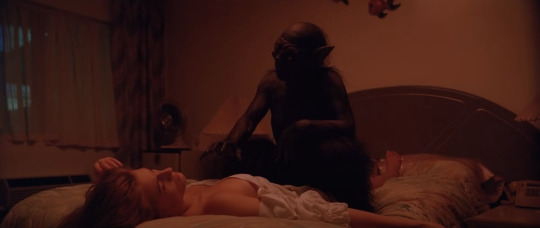
(Screenshot, Delilah, 2015)
A Lost Battle
The opening scene and the end show a crushed man in an office building dressed in unremarkable black attire. This kind of workplace is battle-field and throne room alike to the “Kings” of our age. This very well might be all that is left from a lost battle. Cleared out office space, empty bookshelves, and a broken man still in rage after losing his stance, maybe his identity even. It seems even more poignant to witness the many expressions moving across his face as he tries to listen to what Florence has to say. After hearing the words “I am no mother” he immediately loses interest and starts turning away, perhaps suggesting he lost respect for her at that moment. These very small understated but very articulate moments throughout the video give it a power and show an innate understanding of the issues and emotions addressed in the song.
“As an artist, I never actually thought about my gender that much, I just got on with it… Thinking about being a woman in my 30s and the future, I suddenly feel this tearing of my identity and desires. That to be a performer, but also to want a family might not be as simple for me as it is for my male counterparts… I have to make decisions they did not.” - Florence Welsh
This statement accompanying the release of the single and video, has been picked up by many online outlets to describe the themes explored in the project. However, it seems lazy to imply this is all we see and hear. There’s a complexity and ambivalence within the song and video, which often goes missing when trying to portray these nuanced, systematic issues surrounding gender in a single music video.
What if this depiction of Florence as a powerful otherworldly being is also another commentary on a long-standing tradition of mystifying the “elusive female”? The apparently inherently chaotic, treacherous and seductive? A male perspective to which women have been subjected to. A very clear example would be the witch hunts for instance, where predominantly women were accused of such sorcery for several reasons. Perhaps the accused lived alone, didn��t want children, didn’t have children, had too many children, or not enough. Maybe she had too much money or simply had red hair. In any way, shape, or form a woman would stray away from what was expected to be her role in society, she would immediately be punished for it. This included burning at the stake or more often being hung. Whereas the fewer men accused of sorcery were always suspects solely for being associated with already sentenced women. So, are we witnessing a woman coming into her own powers in the video? Or are we seeing what this broken man fears women to be? Is there blame placed on her instead of acknowledging his own shortcomings? Does he believe to end up paralyzed, cold and dead, if she were to have her own way? The end would suggest we witnessed his imagination, his dream perhaps, as he stands there, alive, even relieved to see Florence this time around standing on a desk. Has he gotten away with it? Only to then be fully consumed by a short haunting breath?

I refuse to believe that any kind of fever-dream would be so articulate. We wouldn’t see Florence in such a forgiving light. She killed a man on screen, yet we are far from thinking of her as evil because of it.
Perhaps trying to pin any of this down, grabbing it, and trying to contain it in concrete is pointless as this specific and again ambivalent lyric suggests:
“But a woman is a changeling, always shifting shape. Just when you think you have it figured out something new begins to take”
She isn’t and never was one thing...
Watch KING
#florence welch#florence and the machine#king#trackmag#trckmg#music#music review#music video review#music analysis#indie rock#alternative music#autumn de wilde#royal#vampires#vampire#boo hag#nachtmahr#musik#musik rezension#musikmagazin#musikvideo#hexen#hexe#witches#witchcraft#art history#kunstgeschichte
12 notes
·
View notes
Text
Turtle Doves And Pigeon Shit
Romanticism And James Blake`s Can`t Believe The Way We Flow
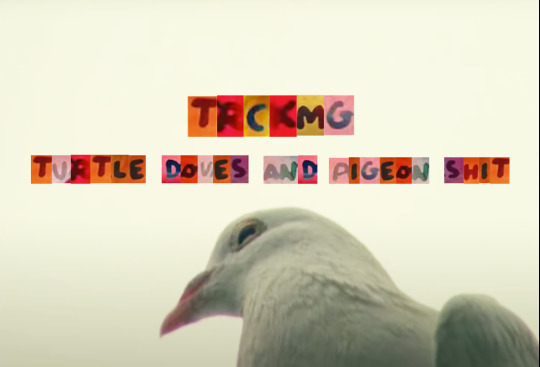
Romanticism could be argued to be outdated, but once we look beyond the clichés and grasp the ideas behind it, we become aware of its relevance today; In how we live, in what we believe in and argue about.
James Blake released the album Assume Form in 2019. He so far has released 5 Music Videos alongside it, one of which is the video for “Can`t Believe The Way We Flow” directed by none other than Frank Lebon. Frank`s approach to his videos and work so far has been a lush and somewhat wild mixture of techniques and media, leaving him with a massive pot of footage and tools for the hours he spends editing. To some degree even this approach of mixed media is in a sense very true to the fashion, believe and tradition of romanticism. This and many other aspects of the video, is what I hope to discuss and further investigate in the following TRCKMG entry.

Still 01, Can`t Believe The Way We Flow, 2019.
A Short Introduction To Romanticism
Romanticism. I am not referring to roses, boxes of chocolates and the numerous red silk bows we see on valentine`s day. I hereby am referring to an epoch also known as the romantic period. Speaking roughly of romanticism we think of a time between the end of the 18th towards the end of the 19th century. This slice of our history is marked by many very major political and cultural events across Europe and the globe. Some worth mentioning here would be the French revolution (which is often believed to be a starting point of the French romanticist movement) and the industrialization, marked by heavy machinery, steam engines, factories and therefore factory labour. We do, however, believe that the origin of romanticism as a term and way of thinking lies in Germany. Friedrich Schlegel, a German philosopher, author and poet first used the term “romantisch” believed to be in reference to the word “Roman” which is German for novel. Romantic therefore being “novel-like”.
From there on romanticism spread fast across Europe supported by the events described earlier. More than just a fashion moment, romanticism describes a different way of thinking in direct contrast (and perhaps in protest) to the inhumane labour happening in factories caused by the industrial revolution. People needed to believe in something, in more relevant things, in nature, in purity, in emotion and in beauty. So not surprisingly romanticism manoeuvred like a wave, spreading across fine art, literature, poetry and even medicine. What we can see in many paintings of that time, are vast and lush landscapes. Nature at its most triumphant, often alongside a tiny human figurine, humbled by mother nature, reminding the human of his place and scale in this world. This emphasized by the Lyrics in the song: “I`m finding I`m a smaller piece than I thought. Oh no I really am”. Even back then, the immediate threat facing the natural world was carefully depicted in William Wordsworth`s poetry with the arrival of factory buildings and nearby compounds of living quarters for the workers.

Painting by Hans Gude, “Fra Hardanger”, 1847.
With this surface level introduction to romanticism, we now can take a closer look at the actual Music Video for “Can`t Believe The Way We Flow”:
Act One: Red Lit Couples
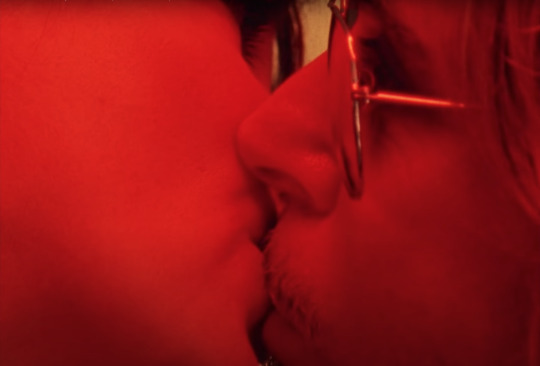
Still 02, Can`t Believe The Way We Flow, 2019.
The Video starts off with a zoom into a mirror. The reflective image reveals James sitting on a bench. The continuation of the zoom is made with invisible cuts while dark silhouettes pass by, covering James for a mere flash of a blacked out frame. He appears closer and closer after each such black-out. Meanwhile you can hear the pigeons take flight, signalling a start to the song and video - take off. And with the first pigeon shit landing on James` cheek, it`s clear the video with its main plot now begins and the subjects appear.
The 2nd time we hear Can`t Believe The Way We Flow in the Lyrics, the lips of the red lit couples meet. The images flashing by are fragments of their lives in relationships. We aren`t meant to immediately understand who they are, where they`re coming from and maybe more importantly what exactly they`re up to. We only see aspects that should be familiar to anyone who`s ever been in a relationship. For instance, being the most intimate during breakfast where spontaneous conversations can leave you happy as ever or absolutely gutted and devastated, maybe also depending on what occured the night before.
Another place where we find a kind of intimacy where the shared space really gets noticeable to us as lovers, is the bathroom. Apart from the hints of breakfast scattered throughout the video there`s also the toilet. Waste. The toilet which stereotypically always seems to spark arguments. Flush the damn thing, put the seat down, put it up and then down. But it`s also the same space in which we share our toothpaste, standing in front of the mirror before bed. Leading conversations whilst getting ready to go out together. The point being, these images are highly familiar and highly emotional to us. The small window in which Frank lets these images flash across our screens is enough for us to recognize and connect. These are couples in their banalities. We aren`t meant to understand how they got there and where they`re going. We`re supposed to draw from our own experiences, our own relationships when seeing these fragments and glimpses into their lives. It`s a reflection. We still are looking into that same mirror from the first shot of the video, remember?
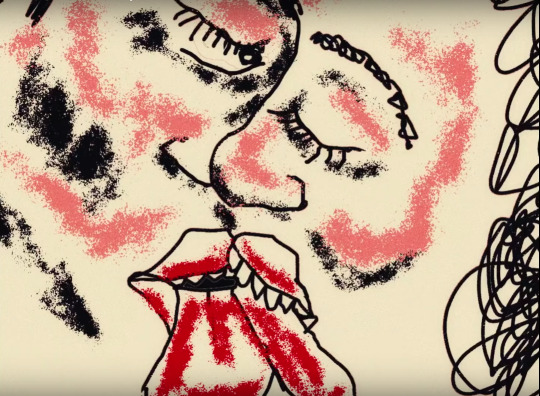
Still 03, Can`t Believe The Way We Flow, 2019.
Cut between the kisses is a 2D animated kiss, in the same style as the quick drawing we saw flash by on a table earlier. It might be a glimpse into the Storyboard for the video, adding another layer and texture to the visuals. This approach alone can also be read as a nod to romanticism as there was a high exchange between different media and artists. Poets and painters, novelists and sculptor. All echoing and responding to eachother`s work.
Throughout all of this we see James remain seated on that same bench, from the very first frame of the video. An observer. In romanticism, as a response to the capitalist mentality, the flâneur describes a person seen wandering around with nowhere to be or go. Observant, most likely unemployed, playful and sensitive to his surroundings. James is very likely maintaining this role in the video. The careful bystander, observing the beauty around him. Beauty that lies hidden for most others in their hectic lives.
Act Two: Pigeons, Cupid and a Gun
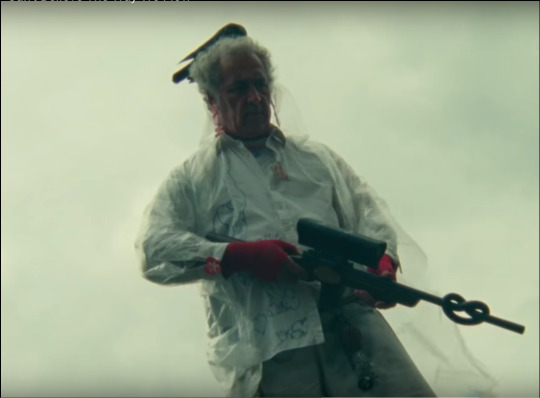
Still 04, Can`t Believe The Way We Flow, 2019.
A culmination of shots of pigeons (and some seagulls) in flight. Close-up of a pigeon`s face, slowly revealed to be sitting on someone`s head. This someone is Frank Lebon`s dad, photographer Mark Lebon. Here he`s also cupid. A cupid who has aged and traded his bow and arrow off for a knotted sniper gun.
Cupid is often described as a winged, nude, young boy armed with bow and arrow. He`s usually depicted as somewhat cruel and mischievous, very aware of what emotional turmoil he can cause in people. Cupid as a figure derives from roman mythology and is considered to be the god of love, or rather the god of being in love. The roman cupid is also understood to be somewhat based on the Greek god Eros, who some believe was a son to the goddess Venus. Eros and Cupid can`t be defeated, any- and everyone falls victim to them and their power. In the following painting, artist Julius Kronberg captured Cupid in his full demeanour in 1885, so towards the end of classic romanticism:

Painting by Julius Kronberg, Cupid, 1885.
Now in comparison to Frank`s take on Cupid we immediately notice the age difference. The world in many ways has become what romanticists had feared; Industrial, concrete, consumerist. Perhaps Cupid had to adjust to survive? Lose his wings and grow up. Wrapped in what seems to be a pvc jacket, not unlike the medical protective suits we currently see a lot. His outfit also contains sketches and scribbles of genitalia. Colours white and red, famously used in the medical field, also symbolizing purity, lust, sin and romance. He`s also wearing red earrings and cufflinks decorated with a more traditional depiction of cupid.
The gun on the other hand, knotted, could also be a nod to the Non-Violance sculpture by Carl Fredrik Reuterswärd, which is in New York. Perhaps a rather twisted musical reference, as that sculpture was made in remembrance of John Lennon. The seemingly unusable gun however, does hold a heart shaped scope through which the absent minded and complacent looking Cupid is aiming to find his next victims.
Enrolling the pigeons to take over the flying and firing arrows part, they soon after take flight once again and a montage of numerous pigeon shit landings are shown, including another drawn Animation of the pigeons` droppings turning into a falling human figurine. Perhaps falling, as in falling in Love, falling for you. Cupid bringing or rather dropping this person into your life. This sequence is concluded by acts of violence followed by tenderness. A slap, a hit, like when love “hits” you. Shortly followed by a gentle caress of the cheek, as though nothing ever happened. So in love that you`re not aware of the violence and force it potentially holds. Another short Animation, single flower turns into a tree, which transforms into a couple in love, a heart in the middle.
Act Three:
Cut to seagulls instead of doves above James. Perhaps accentuating him to be different from all others around him, once again emphasizing his role as flâneur? Or maybe it`s just a subtle teaser for his following music video for I`ll Come Too, which was the next release, featuring a penguin and an albatross.
The couples, still lit in red are holding hands, and then facing the camera. Every individual on their own, staring into the lens, or at their partner. Keeping the mirror in mind from the beginning, this is another very common way for cinema, film and video to become reflexive (film with self-awareness) challenging the viewer in their passiveness and voyeurism.
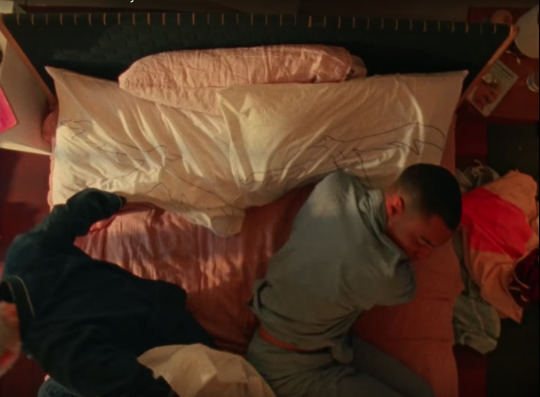
Still 05, Can`t Believe The Way We Flow, 2019.
The doves once again present by appearing as illustrations on the cushions of one couple. All the people involved appear in lettering over the faces of the couples, including a cameo by the director. Another beautifully added layer to this multimedia approach that lends it`s charm and texture to the entire complex romantic experience.
There`s so much more to see and discover in the video than what I have tried to contain in this analysis. I do hope you`ll go on a search yourselves. The video for James Blake`s song Cant Believe The Way We Flow is linked below:
youtube
#james blake#frank lebon#romantic#romanticism#romanticist painting#music analysis#music video#trckmg#taylor joe#editing#doves#pigeon#cupid#assume form#pitchfork#nme magazine#flaneur#cant believe the way we flow#retrograde#travis scott#rosalia#wilhelm screa#you're too precious#valentines day#valentine#roses#chocolate#long reads#music blog#musicvideo
20 notes
·
View notes
Text
Colour And Narrative
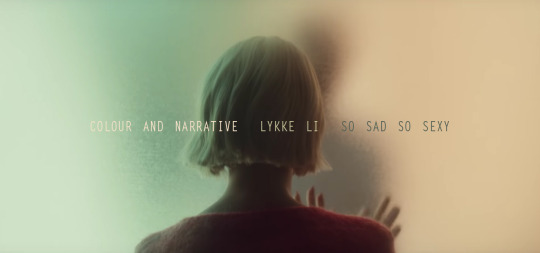
The Human Eye has the capacity to recognize, and tell apart over a million different colours, yet language has failed to capture more than a handful in comparison. In Film, one was so desperate to include colour from the start of its creation, that there were numerous filmmakers around 1895 and 1950 that hand coloured each individual frame, as seen in the famous example by the Lumière Brothers and their Serpentine Dance from 1899. There was also a technique called ‘tinting’ which would allow filmmakers to tint the entire roll of Film, or larger sections of it in a colour of their choosing to deliberately shift or exaggerate the narrative of their stories.
With Digital Film a new world of opportunity opened for us as filmmakers and consumers. Every hue, luminance and saturation became available to us.
Directors like the Lumière Brothers were, or Wes Anderson is, have been fully aware of the fact that colour always produces a psychological reaction in us viewers. Historically we have gained knowledge of different associations to colour which, depending on the cultural background can vary, the sentimental knowledge however seems to be fairly accurate throughout all human beings.
Red for instance is globally associated with Fire and Blood. Therefore, also a symbol of warmth, passion and love but also aggression and destruction. These associations can be a striking tool to further elevate, or shape the narrative of a film.
Another great aspect or talent of colour and colour schemes is, that when used correctly, it results in cohesiveness. This is something we could all witness with the release of Lykke Li`s latest full length album called ‘So Sad So Sexy’. All three of the so far released Music Videos share a very similar colour scheme. This analysis deals with how the colours have been utilized in Lykke`s new releases, especially in the video for ‘Hard Rain’.
What we have established before, is that certain colours are chosen to be read and understood in certain ways. However, these previously mentioned associations (red = fire, blood, love) are not to be read as a clear set of rules to follow. It is less important to think of these colours as fixed expressions synonymous to certain adjectives but nonetheless important to pay attention to them, in order to find their specific place and meaning in a film. There have been decisions made on why, and where what colour appears. This is reason enough for us as viewers to stay alert and find the subjects which are connected to the colours. If they are actual protagonists which keep and hold a certain colour, or maybe a feeling which is visually expressed through colour.
Hard Rain
Hard Rain has many visually compelling tools. What I find impressive about this project SoSadSoSexy by Lykke Li, is the cohesiveness in the Sound AND Look of the Album. The Colours in all three in the following order released Music Videos: Utopia, Deep End and Hard Rain, are reoccurring in every single one. In the Case of Deep End, there were even previews of certain settings, and locations for Hard Rain. These seemingly small details connect all three Videos beautifully, without it feeling forced or contrived.
What Hard Rain in particular works with, is the complementary colour scheme. Where you use two colours which are in direct opposition to their counterpart on the complementary scale. None of the pairs within complementary colours dominate the other. If mixed they would end up being a light to dark grey. They cancel each other out so to speak.
By taking these opposites we already have a platform for narrative. We know these are two polar opposites, we know that none is stronger than the other. Naturally when Lykke is placed in the middle, in between two colours, we expect a border, or the fading of.

The Video starts out with Lykke and her Lover kissing in a shower, a clear shower curtain between them, keeping them mechanically and synthetically apart. There is a strong red light projected onto Lykke’s back, whereas her lover on the other side of the curtain is lit in green. These two colours are complementary to each other. Therefore, the border between the two is hereby the shower curtain. We know that these colours are vibrant on their own, but fail to mix and blend to produce another vibrant colour. So, there is a sense of danger which feeds into the Idea of both of them (LykkeRed and LoverGreen) touching or engaging with one another, as this may result in them losing themselves without gaining a new. Before we move onto the next shot, which is the title screen of the video for hard rain, also completely drenched in red, we witness the Lover`s hand slide under the curtain and grab onto Lykke`s shoulder blade. A trespassing, musically underlined like we`re used to in horror films. The story has begun.
Her Lover now walks down a hall which again is lit in red. He is now moving freely in her space. Lykke in her red jumper moves in the opposite direction. The red getting paler with each step, halting in a still vibrant pink. We see pond lilies from above, a pair of frogs walking on them. Both in a similar direction, sharing the pool like Lykke and her Lover. Here we see again the red and green imagery. Above water is red whereas everything beneath the waterline is green. And again, as a result to these opposites we have a clear accentuated border (here the waterline) cutting the image in half.

Still in the theme of water, we now arrive at a fish store with the couple. A sad trend in the pet-industry is to manipulate the lighting of fish tanks in order to let mainly tropical freshwater fish appear in a more toxic vibrant neon colour scheme, similar to the flashy colours of reef fish, rather than showing their natural colouration. This ‘fake’ light is flooding the entire room. Tinting the couple in their seemingly happy relaxed state. We see Lykke back in the pool alone, in a bright red dress creating gorgeous lavish shapes, followed by a ‘Match Cut’ through the Image of a red betta fish and it`s flowy fins, mimicking the dress we`ve just seen. Aligning these two images to one another, let’s us overlap Lykke`s and the fish’s experience in an elegant and obvious way. Her lover bought her the fish, trapped in a plastic bag. This could be read as an Omen to where Lykke is heading in the storyline, feeling trapped.

After clinical and playful neon lights and a quick flickering of images, one of which is the couple sharing a bed, the covers being green while bedsheets and pillows are dark red, we arrive in the heart, and seemingly most authentic raw part of the video. A short break, natural lighting, a sunset in the background, the couple`s touching foreheads, mimicking each other’s movements. What potentially could have been an awkward moment in a music video, is a refreshing and genuine halt within the story, Lovers being oblivious to the rest of the world, only perceiving each other.
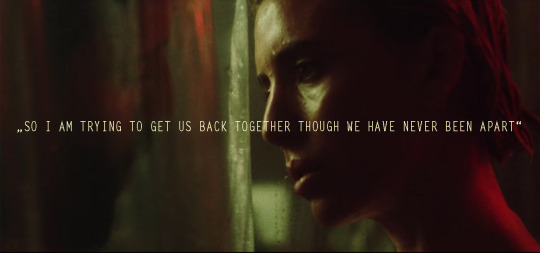
This Lyric is very well applicable to the usage of the complementary colour scheme within the video. It focuses on the opposites between the two, sharing the same space yet always divided, if through curtain or waterline or just natural occurring border where one colour ends and the other starts. It also, of course, is heart of the song itself and where the couple in their relationship are heading towards.
From here on the gap, or wall between the couple seems to manifest itself in growing impatience and frustration in Lykke. The colours mainly remain red and green or shift to orange and blue, which again are complementary. What is interesting when looking at the following Image, is the compositional aspect in addition to the colours. Whereas the blue on Lykke’s side claims more space than the orange, her lover does the same by occupying more space in the frame than her. The colours alone seem unbalanced, but once we add the associated bodies, it appears perfectly balanced.

We arrive at an image reminiscent of the opening scene. Lykke and her love interacting through a physical and transparent separation. Contrary to the opening scene this divider isn’t flexible, nor is it as clear for her to see through, as the shower curtain. It appears decisions have been made on her side which have set, like the glass dividing the two. She no longer interacts or even looks at her former love interest, who is still trying to reach out through the wall.
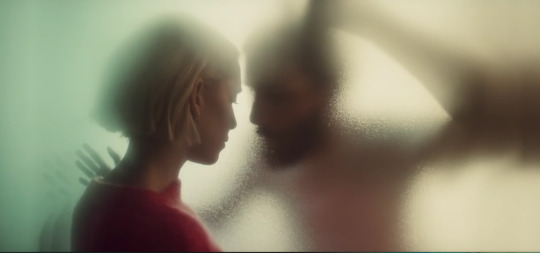
Interestingly we see three dominant colours this time around. Lykke occupying the left corner in her red jumper, stands near green, whilst her Lover on the other side of the barrier occupies the larger portion of the image in a peachy orange. Is the addition of a third colour introducing something new to the story? A dynamic implementing where the story is headed, or simply suggesting that the conflict might be resolved here? Lykke leaving him in this orange space while she leaves the green empty, maybe for someone else to fill?
Whichever way we choose to interpret these colours, there is an underlying theme and association with our subjects throughout the video which is undeniable. Let`s choose to see these colours and try to use language to expand on what we perceive as narrative. Colours can be a very reliable, unassuming and elegant way to further transport a story, as well as generate a sense of cohesiveness throughout a project, which relies on colour schemes, as a kind of by product.
Watch HARD RAIN
#lykke li#sosadsosexy#so sad so sexy#album#musicvideo#music review#pitchfork#nme magazine#online magazine#colour#colour theory#colour and narrative#taylor joe#complementary colours#color#music analysis#analysis#trackmag#trckmg
1 note
·
View note
Text
GRAIN AND NOSTALGIA

By reference to Charlotte Day Wilson`s STONE WOMAN
Analysis by TaylorJoeBerger
Super8 film and VHS aesthetics are currently going through a big revival in music videos. Whilst some examples lack purpose or ambition, this Video seems fitting for both song and sentiment.
The intimacy in “Stone Woman” is clearly reflected in the accompanying video and it`s production, where according to the director Devon Little, only a team of 5 people was on Set.
Whilst Charlotte Day Wilson sings of this stone woman with weathered eyes and heavy sighs, we see imagery which couldn`t be warmer and more welcoming to us. Here lies the illusion and charm of it all. As we of 2018 live in a time of High Definition, whatever we perceive as an analog signal, like Super8 film perhaps, there immediately is a nostalgia which creeps up in us as viewers. Although the VHS and Super8 aesthetic today is also mostly created through filters, which again is a digital signal, referencing what once was. Even within this technical observation there is nostalgia. A time that passed, which we can`t regain, won`t relive, only romanticize and try to recreate through what we call filters.
It comes to no surprise that the director Devon Little references David Bowie`s “Heroes” (1977), Sinead O`Connor`s “Nothing Compares 2U” (1990), and Andy Warhol`s “Screen Tests” (1964 - 1966), as source of inspiration for the Stone Woman video. Especially the opening of both videos by Bowie and Wilson, which share a strong Back-Light and their silhouette in center.

There`s an undeniable quality in the simplicity of all the videos named above, but they also share a grittiness and grain which will, and does, have an affect on us viewers in 2018. Considering that young audiences now grow up with and in High Definition, never experiencing tape as a standard system, seeing grains and filters like these, mean a different thing to them, as they do for us. Where People can put their own memories alongside these visuals, future generations must perceive them as something quite alien. A document, a time capsule, an aesthetic choice but with no personal relevance to them. Something their parents of grandparents had, “abstract”. Even more fascinating how willingly the VHS aesthetic is currently being used for so many music - videos, instagram stories, etc. Although the artists using this grained image might have grown up with it, part of their audience hasn`t.
When comparing the “Stone Woman” video with the inspirational examples, one might say they are very similar technically. As one of the biggest giveaways for the 2018 version of grain, or the digital interpretation of Super8 film lies in the format. We took the now very calculated glitches and picture errors from Super8, but kept our new standard digital resolution and aspect ratio, which is 16:09.
Who is then this stone woman? Is she untouchable for the exact same reasons as we`ve established above? Elusive like the memory held by our grained films, home movies? A figure from the past? Some who we`ve all thought about since; where are you now? What are you up to these days? Or even more absolute, what if you were still here with me?

Towards the end, Charlotte Day Wilson (I like spelling out her name) seems to break out of this stone facade she was in before. Her face lightens up, glances to the side, spontaneous. In direct contrast with what we`ve seen before. Was she singing about herself all along? Having difficulty to grasp oneself? “But if I could catch you I`d be grown” she sings. The longing for catching this figure, understanding this woman, might as well be a search of a self which she is, was, or wants to be?
The silky tone of Wilson`s voice seems to go hand in hand with the grainy imagery of the music - video. A rich voice supported by rich colour, all entangled in an honest simplicity.
Whichever perspective we inhabit, the stone woman is heavy, mysterious and elusive. Charlotte Day Wilson, so far, has proven that she is very particular in her music and in her imagery. She seems to be very aware of what image she is building outwardly. We should all be excited for what`s to come.

Watch the video HERE
#Charlotte Day Wilson#charlottedaywilson#stonewoman#stone woman#stonewomanep#work#taylorjoeberger#trackmag#review#musicvideo#music review#2018#spring 2018#new releases#music#analysis#daniel ceaser#badbadnotgood#toronto#switzerland#grain and nostalgia#grain#nostalgia
3 notes
·
View notes